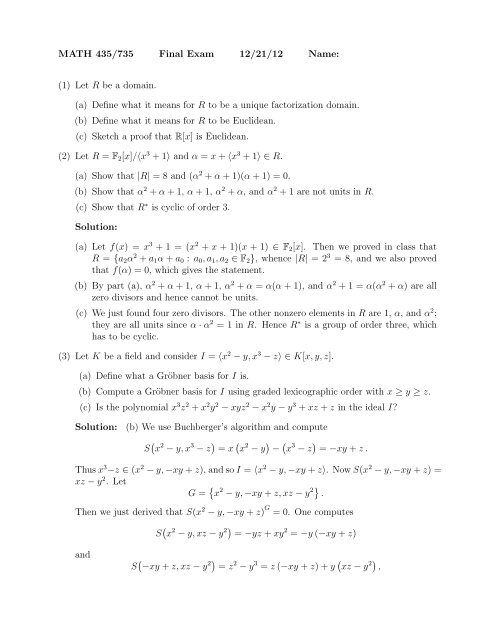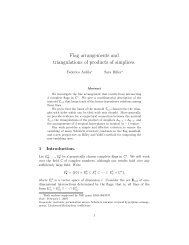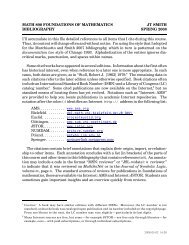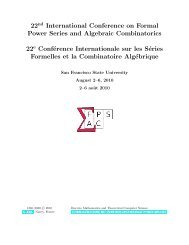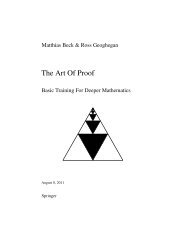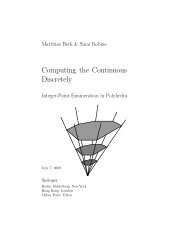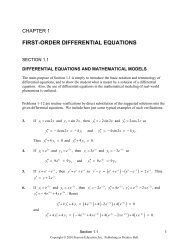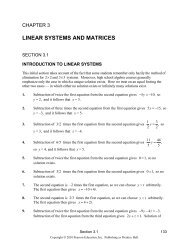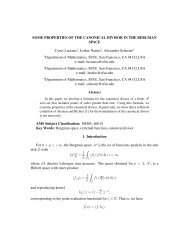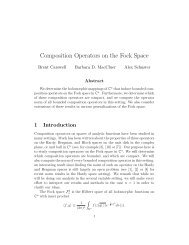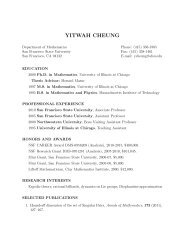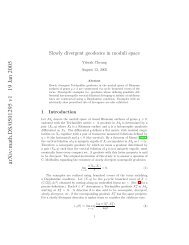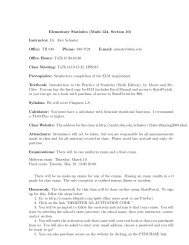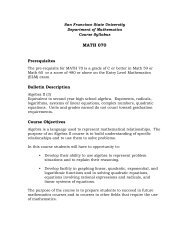MATH 435/735 Final Exam 12/21/12 Name: (1) Let R be a domain ...
MATH 435/735 Final Exam 12/21/12 Name: (1) Let R be a domain ...
MATH 435/735 Final Exam 12/21/12 Name: (1) Let R be a domain ...
You also want an ePaper? Increase the reach of your titles
YUMPU automatically turns print PDFs into web optimized ePapers that Google loves.
<strong>MATH</strong> <strong>435</strong>/<strong>735</strong> <strong>Final</strong> <strong>Exam</strong> <strong>12</strong>/<strong>21</strong>/<strong>12</strong> <strong>Name</strong>:<br />
(1) <strong>Let</strong> R <strong>be</strong> a <strong>domain</strong>.<br />
(a) Define what it means for R to <strong>be</strong> a unique factorization <strong>domain</strong>.<br />
(b) Define what it means for R to <strong>be</strong> Euclidean.<br />
(c) Sketch a proof that R[x] is Euclidean.<br />
(2) <strong>Let</strong> R = F2[x]/〈x 3 + 1〉 and α = x + 〈x 3 + 1〉 ∈ R.<br />
(a) Show that |R| = 8 and (α 2 + α + 1)(α + 1) = 0.<br />
(b) Show that α 2 + α + 1, α + 1, α 2 + α, and α 2 + 1 are not units in R.<br />
(c) Show that R ∗ is cyclic of order 3.<br />
Solution:<br />
(a) <strong>Let</strong> f(x) = x 3 + 1 = (x 2 + x + 1)(x + 1) ∈ F2[x]. Then we proved in class that<br />
R = {a2α 2 + a1α + a0 : a0, a1, a2 ∈ F2}, whence |R| = 2 3 = 8, and we also proved<br />
that f(α) = 0, which gives the statement.<br />
(b) By part (a), α 2 + α + 1, α + 1, α 2 + α = α(α + 1), and α 2 + 1 = α(α 2 + α) are all<br />
zero divisors and hence cannot <strong>be</strong> units.<br />
(c) We just found four zero divisors. The other nonzero elements in R are 1, α, and α 2 ;<br />
they are all units since α · α 2 = 1 in R. Hence R ∗ is a group of order three, which<br />
has to <strong>be</strong> cyclic.<br />
(3) <strong>Let</strong> K <strong>be</strong> a field and consider I = 〈x 2 − y, x 3 − z〉 ∈ K[x, y, z].<br />
(a) Define what a Gröbner basis for I is.<br />
(b) Compute a Gröbner basis for I using graded lexicographic order with x ≥ y ≥ z.<br />
(c) Is the polynomial x 3 z 2 + x 2 y 2 − xyz 2 − x 2 y − y 3 + xz + z in the ideal I?<br />
Solution: (b) We use Buch<strong>be</strong>rger’s algorithm and compute<br />
S x 2 − y, x 3 − z = x x 2 − y − x 3 − z = −xy + z .<br />
Thus x 3 −z ∈ (x 2 − y, −xy + z), and so I = 〈x 2 − y, −xy + z〉. Now S(x 2 − y, −xy + z) =<br />
xz − y 2 . <strong>Let</strong><br />
G = x 2 − y, −xy + z, xz − y 2 .<br />
Then we just derived that S(x 2 − y, −xy + z) G = 0. One computes<br />
and<br />
S x 2 − y, xz − y 2 = −yz + xy 2 = −y (−xy + z)<br />
S −xy + z, xz − y 2 = z 2 − y 3 = z (−xy + z) + y xz − y 2 ,
so that S(x 2 − y, xz − y 2 ) G = S(−xy + z, xz − y 2 ) G = 0. Hence G is a (in fact, reduced)<br />
Gröbner basis for I.<br />
(c) The division algorithm gives<br />
x 3 z 2 + x 2 y 2 − xyz 2 − x 2 y − y 3 + xz + z = x 2 − y xz 2 + y 2 + (−xy + z) x + z ,<br />
so that (x 3 z 2 + x 2 y 2 − xyz 2 − x 2 y − y 3 + xz + z) G = z is nonzero, whence<br />
x 3 z 2 + x 2 y 2 − xyz 2 − x 2 y − y 3 + xz + z /∈ I .<br />
(4) <strong>Let</strong> R, S, and T <strong>be</strong> rings, and let M and N <strong>be</strong> R-modules.<br />
(a) Define what it means for φ : S → T to <strong>be</strong> a ring homomorphism.<br />
(b) Define what it means for ψ : M → N to <strong>be</strong> an R-module homomorphism.<br />
(c) Show that the factor rings F3[x]/〈x 2 + 1〉 and F3[x]/〈x 2 + x〉 are<br />
• isomorphic as F3-modules,<br />
• non-isomorphic as rings.<br />
Solution: (c) <strong>Let</strong> f = x 2 + 1 and g = x 2 + x. Then any polynomial h ∈ F3[x] can <strong>be</strong><br />
written as h = a1x + a0 + 〈f〉 and h = b1x + b0 + 〈g〉 for some a1, a0, b1, b0 ∈ F3.<br />
The map φ : F3[x]/〈f〉 → F3[x]/〈g〉 given by<br />
φ (cx + d + 〈f〉) = cx + d + 〈g〉<br />
is a module isomorphism: If c1x + d1 + 〈f〉 , c2x + d2 + 〈f〉 ∈ F3[x]/〈f〉, then for any<br />
λ ∈ F3,<br />
φ (λ (c1x + d1 + 〈f〉) + (c2x + d2 + 〈f〉)) = φ ((λc1 + c2) x + (λd1 + d2) + 〈f〉)<br />
= (λc1 + c2) x + (λd1 + d2) + 〈g〉<br />
= λ (c1x + d1 + 〈g〉) + (c2x + d2 + 〈g〉)<br />
= λ φ (c1x + d1 + 〈f〉) + φ (c2x + d2 + 〈f〉)<br />
and ker(φ) = 〈f〉. Since φ is apparently onto, the module isomorphism theorem gives<br />
the statement.<br />
The polynomial f is irreducible over F3 (<strong>be</strong>cause it has no roots), so F3[x]/〈f〉 is a field.<br />
On the other hand, F3[x]/〈g〉 has zero divisors (e.g., (x + 〈g〉) (x + 1 + 〈g〉) = 〈g〉), and<br />
so F3[x]/〈g〉 cannot <strong>be</strong> ring-isomorphic to F3[x]/〈f〉.


